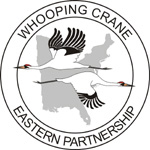 Media Contact: Joan Garland 608-381-1262 Media Contact: Joan Garland 608-381-1262
As a pair of Whooping Cranes remains in North Carolina’s Clay County, the U.S. Fish & Wildlife Service urges spectators to maintain their distance in order to not spook the cranes and reduce their familiarity with humans.” These cranes are among the rarest animals on the planet. In our efforts to recover this species, I can’t stress enough how important it is for people to give the birds the space they need to feel comfortable and go peacefully about their daily lives of finding food, water, shelter, and developing the bond that will lead to successful nesting in the spring,” said Bill Brooks, a biologist with the U.S. Fish & Wildlife Service. The cranes are part of an effort to establish a migrating flock of Whooping Cranes in Eastern North America, a project headed by a collation of private, state, and federal organizations known as the Whooping Crane Eastern Partnership, or WCEP. WCEP recommends the following guidelines for viewing whooping cranes: • Remain in your vehicle; • Remain at least 600 feet from the birds, unless in a vehicle on a public road, in which case, remain at least 300 feet from the birds; • Remain concealed and speak at a low enough volume that the birds can’t hear you; • Do not trespass on private property.The birds are protected by both the Endangered Species Act and the Migratory Bird Treaty Act. Under the Endangered Species Act, it’s illegal to harass, harm, pursue, hunt, shoot, wound, kill, trap, capture, collect or to attempt to engage in any such conduct, except when it’s accidental and incidental to an otherwise lawful activity such as agricultural practices, construction, or hunting. Violations under the Endangered Species Act are punishable by fines up to $100,000 per individual and up to 1 year imprisonment. Under the Migratory Bird Treaty Act, it’s illegal to pursue, hunt, take, capture, kill, attempt to take, capture or kill, or possess any whooping crane, crane part, nest, or egg without a permit. Violations under the Migratory Bird Treaty Act are generally punishable by fines up to $15,000 and up to six months in prison, though they can be greater, depending on the nature of the violation. The Clay County birds were first reported on December 9, 2011, marking the first time Whooping Cranes have been documented wintering in Western North Carolina. Whooping Cranes are one of the rarest species in the world, with a current estimated global population between 525-550 individuals, which is divided into four main groups. All wild Whooping Cranes are part of a western population that migrates between Canada and coastal Texas and now numbers approximately 300. In 1999 WCEP began efforts to restore a migratory flock to eastern North America. This carefully-managed and heavily-monitored eastern flock began with a small group of captively-reared birds which has grown to more than 100 individuals, including the two found in Clay County. The third and fourth populations are reintroduced populations of nonmigratory Whooping Cranes in Florida and Louisiana. Whooping Cranes were listed as an endangered species in 1967, the result of hunting and specimen collection, human disturbance, and loss of habitat. Whooping Crane numbers dipped to an all time low of 16 individuals in 1941. They once occurred from the Arctic coast to the high plateau of central Mexico, and from Utah east to New Jersey and Florida. Standing almost 5 feet tall, it’s the tallest bird in North America. Adult birds are characterized by snowy white plumage, a crimson crown, long thin black legs, and white wings tipped with black that measure almost 8 feet in length. The plumage of juvenile birds is a mixture of cinnamon and white. Deriving their name from the distinctive whooping call, the call of the Whooping Crane can carry for miles. This release was prepared by the U.S. Fish & Wildlife Service. Learn more about ICF’s commitment to the endangered Whooping Crane. |
  Want more Whooping Crane news? Follow our Whooping Crane migration updates and other news on Facebook. Want more Whooping Crane news? Follow our Whooping Crane migration updates and other news on Facebook.
Make a gift to support Whooping Crane conservation. |


